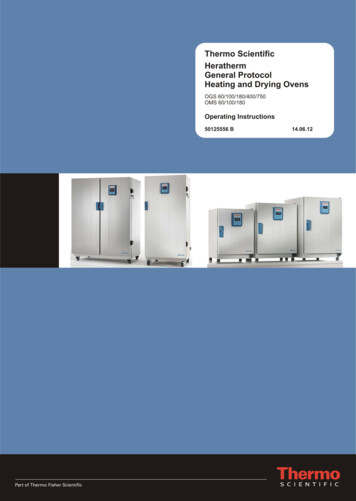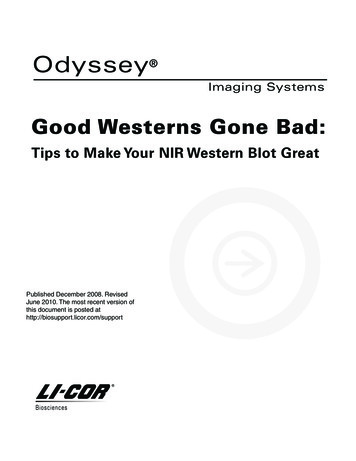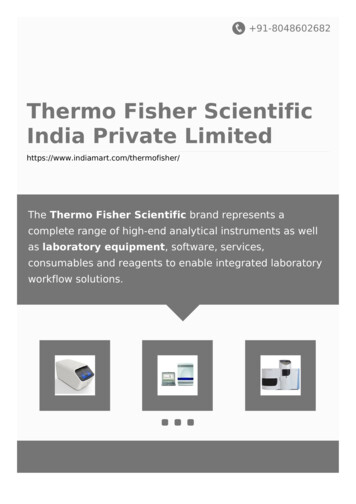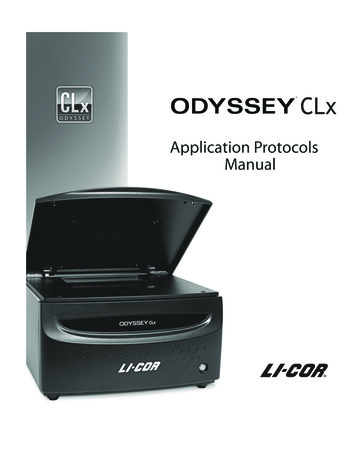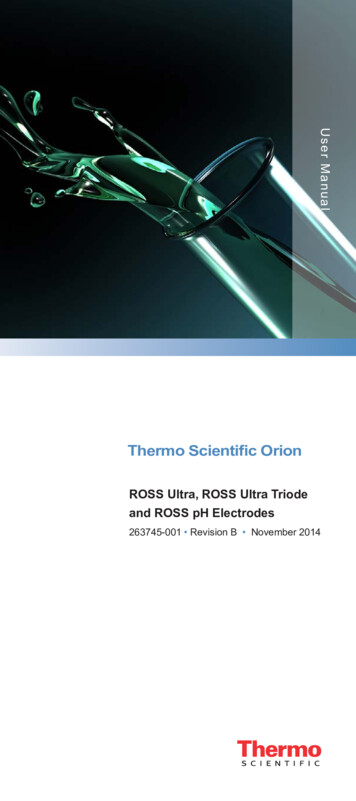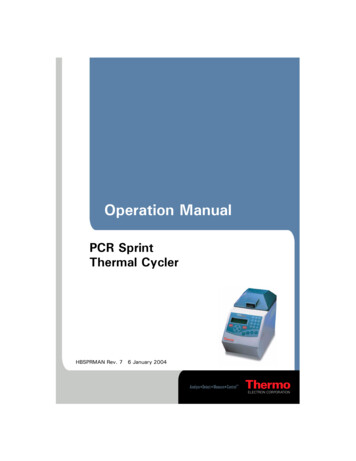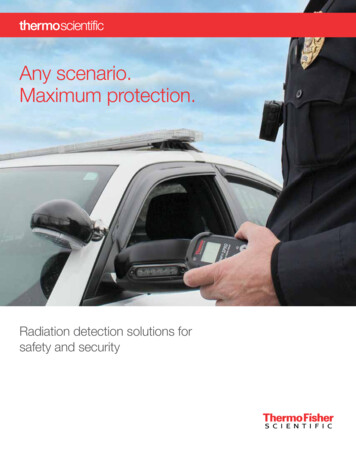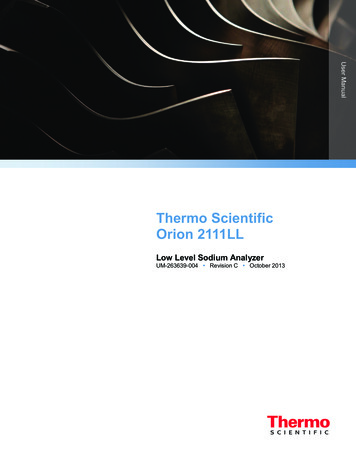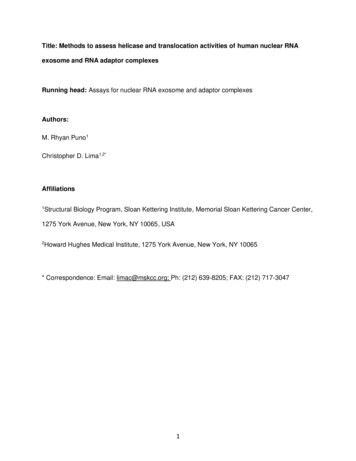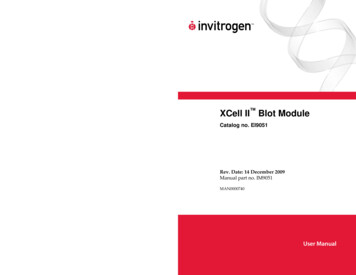
Transcription
XCell II Blot ModuleCatalog no. EI9051Rev. Date: 14 December 2009Manual part no. IM9051MAN0000740Corporate HeadquartersInvitrogen Corporation1600 Faraday AvenueCarlsbad, CA 92008T: 1 760 603 7200F: 1 760 602 6500E: tech support@invitrogen.comFor country-specific contact information visit our web site at www.invitrogen.comUser Manual
2
Table of ContentsTable of Contents.3Product Contents and Specifications .4Overview .5Preparing for Transfer.8Using the XCell II Blot Module .11Testing the Efficiency of Blotting .19Optimizing Blotting Parameters.21Troubleshooting .23Special Applications .26Buffer Recipes .30Accessory Products .32Technical Support .333
Product Contents and SpecificationsContentsSpecificationsThe XCell II Blot Module includes anode core, cathodecore, and sponge pad (8/pack).The specifications of the XCell II Blot Module are:Cell Dimensions:14.5 cm 14 cm 11 cmBlot Module Capacity:200 mL Intended UseXCell SureLock LowerBuffer Chamber Capacity:600 mLBlot Size:9 cm 9 cmFor research use only. Not intended for any animal orhuman therapeutic or diagnostic use.WEEE (Waste Electrical and Electronic Equipment) symbolindicates that this product should not be disposed of inunsorted municipal waste. Follow local municipal wasteordinances for proper disposal provisions to reduce theenvironmental impact of WEEE. Visitwww.invitrogen.com/weee for collection and recyclingoptions.4
OverviewIntroductionWestern or immuno blotting is the transfer of separatedproteins in a gel to the surface of a thin support membranematrix. The proteins are bound and immobilized on themembrane. Southern and northern blotting involves thetransfer of separated DNA and RNA, respectively, from agel to a membrane.To perform a transfer, the gel is layered next to a membraneand placed in a voltage gradient perpendicular to the gel.Negatively charged molecules will migrate out from the gel,move towards the positive electrode, and get deposited onthe membrane.Advantagesof BlottingXCell II Blot ModuleThe advantages of blotting include: Removal of gel impurities from the protein or nucleicacid which may hinder further analysis Easy access of proteins or nucleic acids on a blot forfurther analysis Faster analysis of proteins on the blots as proteindiffusion is minimized Shorter staining and destaining time of proteins on theblot as compared to gels Multiple successive reprobing of a single blot foranalyses after removal of the probe each time Convenient way to store separated proteins or nucleicacids for future useThe XCell II Blot Module is a simple apparatus designed forblotting of mini-gels and is easily inserted into the XCellSureLock Mini-Cell in place of the gel/buffer core assembly.The module has rails to guide the unit into the mini-cell. TheXCell II Blot Module can be used to perform western,Southern, or northern transfer of two mini-gels using only200 mL of transfer buffer. The XCell II Blot Module is asemi-wet transfer unit. An efficient transfer is obtained, asthe resistance is constant across the blotting electrodesproducing uniform field strength.Continued on next page5
Overview, ContinuedThe XCell II Blot Module can only be used with XCellSureLock Mini-Cell or XCell II Mini-Cell. Refer to page 32for ordering information.BlottingMembranesInvitrogen offers three types of blotting membrane and filterpaper sandwiches. Refer to page 32 for ordering information. Nitrocellulose for western or Southern blotting PVDF (polyvinylidene difluoride) for western blotting Nylon for Southern or northern blottingSee the table below for more details on each membrane.MembraneNitrocellulosePropertiesMost widely usedmembrane for westernblottingGood binding capacityProteins bind to themembrane due rn0.2 mtransfer0.45 mAmino acidanalysisSolid phaseassay systemsReprobingNoProtein bindingcapacity: 80 g/cm2Continued on next page6
Overview, ContinuedMembranePVDFPropertiesHigher bindingcapacity thannitrocelluloseStrong hydrophobiccharacter and solventresistantPhysically strongerthan gWesterntransferAmino acidanalysisSolid phaseassay systems0.2 mSouthern,northern andwesterntransfersSolid phaseimmobilizationDry chemistrytest stripsEnzymeimmobilizationGene probeassays0.45 mReprobingYes0.45 mCompatible withcommonly used proteinstains andimmunodetectionmethodsProtein bindingcapacity:50-150 g/cm2NylonMicroporousmembrane modifiedwith strongly basiccharged groupsIdeal for bindingnegatively chargedbiomolecules such asDNA and RNALow background forenhanced resolutionMembrane is formedaround a non-wovenpolyester fiber matrixwhich confers hightensile strength,toughness, andflexibilityYes7
Preparing for TransferYou need to prepare the transfer buffer, blotting pads, andblotting membranes before performing the transfer. Youmay prepare the transfer buffer and materials for transferwhile electrophoresis of the gel is in progress.MaterialsNeeded Pre-cut blotting membranes and filter paper sandwiches Methanol Deionized water Transfer buffer (see below) Shallow tray for equilibration of membranes, filter paper,and blotting padsMENDIONATRECOMIntroductionWear gloves at all times during the entire blottingprocedure to prevent contamination of gels andmembranes, and to avoid exposure to irritants commonlyused in electrophoresis and blotting procedures.Do not touch the membrane or gel with bare hands. Thismay contaminate the gel or membrane and interfere withfurther analysis.PreparingTransferBufferPrepare the appropriate buffer for your gel type from therecipes given below.For Blotting Novex Tris Glycine or Tricine Gels:Prepare 1,000 mL of 1X Novex Tris-Glycine Transfer Bufferusing Novex Tris-Glycine Transfer Buffer (25X) as follows:Novex Tris-Glycine Transfer Buffer (25X)40 mLMethanol200 mLDeionized Water760 mLTotal Volume1,000 mLSee 30 for a recipe of Tris-Glycine Transfer Buffer, if you arepreparing your own transfer buffer.Continued on next page8
Preparing for Transfer, ContinuedPreparingTransferBuffer,continuedFor Blotting NuPAGE Novex Bis-Tris or Tris-AcetateGels:Prepare 1,000 mL of 1X NuPAGE Transfer Buffer using theNuPAGE Transfer Buffer (20X) as follows:ReagentsReducedNuPAGE Transfer Buffer (20X)50 mL1 mLNuPAGE AntioxidantMethanol*100 mLDeionized Water849 mLTotal Volume1,000 mLNon-Reduced50 mL-100 mL850 mL1,000 mL*NuPAGE Transfer Buffer with 10% methanol providesoptimal transfer of a single gel in the blot module. If you aretransferring 2 gels in the blot module, increase the methanolcontent to 20% to ensure efficient transfer of both gels.Refer to page 30 for a recipe of the NuPAGE TransferBuffer, if you are preparing your own transfer buffer.For Blotting Novex TBE or DNA Retardation Gels:Prepare 1,000 mL of 0.5X TBE transfer buffer using theNovex TBE Running Buffer (5X) as follows:Novex TBE Running Buffer (5X)Deionized Water100 mL900 mLTotal Volume1,000 mL See page 30 for a recipe of the Novex TBE Running Buffer,if you are preparing your own transfer buffer.PreparingBlottingPadsUse 700 mL of transfer buffer to soak the blotting padsuntil saturated. Remove air bubbles by squeezing theblotting pads while they are submerged in buffer. Removingair bubbles is essential as they can block the transfer ofbiomolecules.Continued on next page9
Preparing for Transfer, ContinuedPreparingTransferMembraneand FilterPaperUse Novex pre-cut membrane/filter paper sandwiches (seepage 32 for ordering information) or cut selected transfermembrane and filter paper to the dimensions of the gel. PVDF membrane: Pre-wet the PVDF membrane for30 seconds in methanol, ethanol, or isopropanol. Brieflyrinse in deionized water and then place the membrane ina shallow dish containing 50–100 mL transfer buffer forseveral minutes. Nitrocellulose/Nylon membrane: Place the membranedirectly in a tray containing the transfer buffer forseveral minutes. Filter paper: Soak briefly in transfer buffer immediatelybefore using. 10Gel: Use the gel immediately following the run(page 11). Do not soak the gel in transfer buffer.
Using the XCell II Blot ModuleIntroductionThe blotting protocol described below is suitable formajority of protein blotting applications using the XCell II Blot Module. However, some optimization may be necessaryby the user to obtain the best results (page 21).MaterialsNeeded Previously electrophoresed mini-gels (maximum gel size9 cm 9 cm) XCell SureLock Mini-CellRemovingthe GelRemove the gel from the cassette for transfer after completionof electrophoresis as described below. If you are not ready toperform transfer immediately, you may continueelectrophoresis of your gel at a low voltage of 5 V. The gelcan be left in the unit for a few hours until you are ready totransfer the gel.1. After electrophoresis, separate each of the 3 bonded sidesof the gel cassette by inserting the gel knife into the gapbetween the cassette’s 2 plates. The notched (“well”) sideof the cassette should face up.2. Push up and down on the knife handle to separate theplates. Repeat on each side of the cassette until the platesare completely separated.Caution: Use caution while inserting the gel knife between the2 plates to avoid excessive pressure towards the gel.3. The gel may adhere to either side of plates upon openingthe cassette. Carefully remove and discard the platewithout the gel The gel remains on the other plate.4. Remove wells on the gel with the gel knife.5. Place a piece of pre-soaked filter paper (as prepared onpage 10) on top of the gel, and lay just above the “foot” atthe bottom of the gel (leaving the “foot” of the geluncovered). Keep the filter paper saturated with transferbuffer and remove all trapped air bubbles by gentlyrolling over the surface using a glass pipette.Continued on next page11
Using the XCell II Blot Module, ContinuedRemovingthe Gel,continued6. Turn the plate over so the gel and filter paper are facingdownwards over a gloved hand or clean flat surfacecovered with a piece of Parafilm .7. Remove gel from the plate using the following methods: If the gel rests on the longer (slotted) plate, use the gelknife to push the foot out of the slot in the plate andthe gel will fall off easily. If the gel rests on the shorter (notched) plate, use thegel knife to carefully loosen the bottom of the gel andallow the gel to peel away from the plate.8. When the gel is on a flat surface, cut the “foot” off the gelwith the gel knife. Proceed to Transferring One Gel,below.Note: Once you have removed the gel from the unit and the cassette,perform the transfer immediately.TransferringOne GelInstructions are provided below for transferring 1 gel. If youneed to transfer 2 gels at a time, refer to page 15.1. Wet the surface of the gel (step 8, above) with thetransfer buffer and place pre-soaked transfer membraneon the gel. Remove air bubbles by rolling a glass pipetteover the membrane surface.2. Place the pre-soaked filter paper on top of the transfermembrane. Remove any trapped air bubbles.3. Place 2 soaked blotting pads into the cathode (–) core ofthe blot module. The cathode core is the deeper of the2 cores and the corresponding electrode plate is a darkershade of gray. Carefully pick up the gel membraneassembly with your gloved hand and place on the pad inthe same sequence, such that the gel is closest to thecathode plate (see figure below). Blotting PadBlotting PadFilter PaperTransfer MembraneGelFilter PaperBlotting PadBlotting PadCathode Core (-)Continued on next page12
Using the XCell II Blot Module, ContinuedTransferringOne Gel,continued4. Add enough pre-soaked blotting pads to rise 0.5 cm overthe rim of the cathode core. Place the anode ( ) core ontop of the pads. The gel/membrane sandwich should beheld securely between the two halves of the blot moduleensuring complete contact of all components.Note: To ensure a snug fit, use an additional pad since pads losetheir resiliency after many uses. Replace pads when they beginto lose resiliency and are discolored.5. Position the gel membrane sandwich and blotting padsin the cathode core of the XCell II Blot Module to fithorizontally across the bottom of the unit. There shouldbe a gap of 1 cm at the top of the electrodes when thepads and assembly are in place (see figure below).6. Hold the blot module together firmly and slide it into theguide rails on the lower buffer chamber. The blot modulefits into the unit in only one way, such that the ( ) sign isseen in the upper left hand corner of the blot module.The inverted gold post on the right hand side of the blotmodule fits into the hole next to the upright gold post onthe right side of the lower buffer chamber.Continued on next page13
Using the XCell II Blot Module, ContinuedTransferringOne Gel,continued7. Depending on the mini-cell that you are using, followthe appropriate instructions for positioning the wedge: For XCell SureLock Mini-Cell, place the gel tensionwedge such that the vertical face of the wedge isagainst the blot module. Push the lever forward tolock it into place. For XCell II Mini-Cell, place the front wedge(without the screw hole) such that the vertical face ofthe wedge is against the blot module. Slide in therear wedge and push it down firmly.Note: When properly placed, the rear wedge will not be flushwith the top of the lower buffer chamber. There will be a gapbetween the rear wedge and lower chamber.8. Fill the blot module with transfer buffer until thegel/membrane sandwich is covered in transfer buffer.Do not fill all the way to the top as this will generateextra conductivity and heat.9. Fill the outer buffer chamber with 650 mL deionizedwater by pouring in the gap between the front of the blotmodule and front of the lower buffer chamber. Thewater level should reach approximately 2 cm from thetop of the lower buffer chamber. This serves to dissipateheat produced during the run.Note: If you accidentally fill the outer buffer chamber with thetransfer buffer, it will not adversely affect the transfer. Theliquid in the outer buffer chamber serves as a coolant. Werecommend adding deionized water to the outer bufferchamber to avoid any exposure of the mini-cell to methanol asthe mini-cell is susceptible to methanol.10. Place the lid on top of the unit.11. With the power turned off, plug the red and black leadsinto the power supply. Refer to Transfer Conditions onpage 16 for transfer conditions.Continued on next page14
Using the XCell II Blot Module, ContinuedTransferringTwo GelsInstructions are provided below for transferring two gels.1. Remove the gels after electrophoresis as described onpage 11.2. Assemble the gel/membrane sandwich (as described onpage 12) twice to make two gel/membrane sandwiches.3. Place two pre-soaked pads on cathode core of the blotmodule. Place the first gel/membrane sandwich on pads inthe correct orientation, so the gel is closest to the cathodeplate (see figure below). Blotting PadBlotting PadFilter PaperTransfer MembraneSecond GelFilter PaperBlotting PadFilter PaperTransfer MembraneFirst GelFilter PaperBlotting PadBlotting PadCathode Core (-)4. Add another pre-soaked blotting pad on top of the firstmembrane assembly.5. Position the second gel/membrane sandwich on top ofblotting pad in the correct orientation so that the gel isclosest to the cathode side.6. Proceed with Steps 4–11 as described in Transferring OneGel (page 12).Continued on next page15
Using the XCell II Blot Module, ContinuedTransferConditionsChoose the transfer conditions from the table below basedon type of the gel that you are using.Note: The expected current listed in the table below is fortransferring one gel. If you are transferring two gels in theblot module, the expected current will double. For overnightblotting, see next page.Type of the GelNovex Tris–GlycineNovex TricineTransfer Buffer (1X)Novex Tris GlycineTransfer Buffer with20% Nitrocelluloseor PVDF25 V constant Start:for 1–2 hours 100 mANitrocelluloseNuPAGE TransferBuffer with 10%or PVDFmethanol for transfer ofone gel.30 V constant Start:for 1 hour170 mA1X Transfer Buffershould be pH 8.3 beforeaddition of SDS ormethanol. Do notadjust the pH.NuPAGE Novex Bis–TrisEnd:110 mANuPAGE Antioxidantfor reduced samplesNuPAGE Novex Tris–AcetateNitrocelluloseNuPAGE TransferBuffer with 10%or PVDFmethanol for transfer ofone gel.30 V constant Start:for 1 hour220 mAEnd:180 mANuPAGE Antioxidantfor reduced samplesNovex TBE,TBE–Urea, andDNARetardation45 mM TrisNovex IEF*0.7% acetic acid, pH 3.0, Nitrocelluloseor PVDFsee page 27Nylon45 mM boric acid1 mM EDTA30 V constant Start:for 1–2 hours 360 mAEnd:270 mA10 V constant Start: 65–for 1 hour85 mA*Assemble the gel/membrane sandwich in reverse order so that the membrane is on the cathodeside (–) of the gel (page 27).Continued on next page16
Using the XCell II Blot Module, ContinuedOvernightBlottingFor overnight blotting, perform transfer in the cold room withlow power to prevent overheating. Transfer at constantvoltage of 10–15 V overnight. Depending on the transferefficiency, adjust the transfer conditions accordingly.Cleaning theBlot ModuleRinse the blot module with distilled water after use. Toclean any residual build-up in the blot module, apply50% nitric acid in deionized water to areas inside the blotmodule until residual build-up is removed. Do notsubmerge the blot module or soak overnight in nitric acid.Use gloves when preparing the nitric acid solution. Once thebuild-up is removed, rinse the module at least three times indeionized water.Continued on next page17
Using the XCell II Blot Module, ContinuedPostTransferAnalysisAfter the transfer, you may proceed to immunodetection,store the membrane for future use, or stain the membrane. For immunodetection of proteins, use theWesternBreeze Chromogenic or ChemiluminescentImmunodetection Kits available from Invitrogen(page 32) or any other immunodetection kit. For storing nitrocellulose membranes, air dry themembrane and store the membrane in an air-tight plasticbag at room temperature or 4 C. Avoid storingnitrocellulose at –20 C or–80 C, as they will shatter. For storing PVDF membranes, air dry the membraneand store the membrane in a air-tight plastic bag at roomtemperature, 4 C, or –80 C. When you are ready to usethe membrane, re-wet the membrane with methanol fora few seconds, followed by thorough rinsing of themembrane with deionized water to remove methanol. For staining the membranes after blotting, you may use: 180.1% Coomassie Blue R-250 in 50% methanol. Do notuse Novex Colloidal Blue Staining Kit for staining ofmembranes, as the background is high.20 mL of SimplyBlue SafeStain (page 32) with dryPVDF membranes and incubate for 1–2 minutes. Washthe membrane three times with 20 mL of deionizedwater for 1 minute. To avoid high background, do notuse SimplyBlue SafeStain on nitrocellulose and wetPVDF membranes.0.5% Amido Black (page 32) in 50% methanol and10% acetic acid. Remove excess stain with deionizedwater. Destain with 45% methanol and 10% acetic acidfor 30 minutes. Rinse the membrane with deionizedwater and air dry.0.1% Ponceau S (page 32) in 7% trichloroacetic acid(TCA) for 5 minutes. Rinse the membrane in deionizedwater to obtain transient staining or 10% acetic acid toobtain permanent staining, and air dry.If you do not detect any proteins on the membraneafter immunodetection or staining, refer to theTroubleshooting section on page 23. Refer to themanufacturer’s recommendations for optimizingimmunodetection.
Testing the Efficiency of BlottingIntroductionOnce you have performed the transfer, you may check theefficiency of transfer by using any one of the methodsdescribed below. Testing the blotting efficiency helps youevaluate the transfer and optimize transfer parameters toobtain an efficient transfer.We recommend testing the efficiency of blotting when youare performing the western transfer for the first time and ifyou have changed the buffer system or gel type.MaterialsNeeded Pre-stained standards (page 32) Ponceau S or Coomassie stain Transfer membrane Previously transferred mini-gel (maximum gel size 9 cm 9 cm)Continued on next page19
Testing the Efficiency of Blotting, ContinuedProcedureThe following methods can be used to test the efficiency ofprotein transfer.Using pre-stained standards:This is the most convenient way to monitor the efficiency oftransfer. Pre-stained standards are protein markers that arecovalently bound to a synthetic dye. This enablesvisualization of the protein markers during electrophoresisand after the transfer. Invitrogen offers three types of prestained standards (page 32 for ordering information). Thetransfer efficiency is good, if most of the standards havetransferred to the membrane. Note that high molecularweight standards do not always transfer completely and thisis not indicative of incomplete transfer.If none of the standards or only a few have transferred tothe membrane, you may have to optimize the transferconditions. Refer to Optimizing Blotting Parameters on thenext page and the Troubleshooting section on page 23.Staining the gel:The gel can be stained with Coomassie Blue staining or astaining method of choice after the transfer to determine thetransfer efficiency. If significant amount of proteins are stillpresent on the gel after staining, this indicates poor transfer.You may need to optimize the transfer as described on thenext page.Staining the membrane:Stain the membrane after the transfer to evaluate thetransfer efficiency. If you are using the membrane forpeptide sequencing, you may stain the membrane withCoomassie Blue stain.If you are using the membrane for immunodetection, youcan stain the membrane with a temporary stain such asPonceau S (see page 18 for Ponceau S staining). Aftervisualizing the transferred protein bands on the membrane,you can rinse the membrane with deionized water tocompletely remove the staining or incubate the membranedirectly in the blocking solution. Ponceau S stain does notinterfere with most immunodetection methods.20
Optimizing Blotting ParametersIntroductionEach parameter of the blotting protocol plays a role duringthe transfer of proteins. An ideal blotting protocol balanceseach parameter to provide efficient transfer of proteins.When using the XCell II Blot module, most proteins willtransfer efficiently using the protocol on page 12.Based on specific properties of a protein or a set of proteins,some optimization of the blotting protocol may be necessary.Review the points described below to optimize the blottingprotocol.GelPercentageChoose the lowest percentage acrylamide appropriate for themolecular weight of your protein or proteins of interest.Gradient gels are excellent for blotting a range of proteinsizes, as the porosity of the gel matrix is well matched withthe different sizes of the proteins.Some proteins can be equally well resolved on a Tricine gelor Tris-Glycine gel. In general, a Tricine gel will resolve thesame range of proteins as a higher percentage Tris-Glycinegel and can be a better choice for some transfers.GelThicknessThe 1.0 mm thick gels are better for blotting. Be sure to scaleyour sample load appropriately for the sensitivity of yourantibody detection method.FieldStrengthA higher field strength (volts/cm) may help larger proteins totransfer, but may also cause smaller proteins to pass throughthe membrane without binding. Our recommended conditionfor most proteins is 25 Volts for 90 minutes. You may makeminor adjustments ( 5–10V) accordingly, when necessary.See Transfer Conditions. (page 16).Alcohol inTransferBufferDecreasing or eliminating alcohol may improve the transferof some proteins, especially large proteins.For blotting Novex Tris-Glycine Gels and 2 NuPAGE Novex Gels, 20% methanol is added to the transfer buffer(page 8). This is balanced by the residual SDS in the gel fromthe running buffer. Keep this in mind when adjusting themethanol content in transfer buffer.Continued on next page21
Optimizing Blotting Parameters, ContinuedTransferTimeIncreasing the transfer time to two hours will improvetransfer of most proteins, but may cause the smaller proteinsto pass through the membrane. Transfer time usually haslittle influence on the detection of proteins that remainbound to the membrane. Note that transfer times longerthan 2 hours at the recommended power settings do notgreatly improve transfer of proteins that have failed totransfer completely in 2 hours. This may be due to theexhaustion of the buffer or partial fixation of the protein inthe gel as a result of the removal of SDS or a conformationalchange in the proteins during the transfer interval.SDS inTransferBufferAdding 0.01% to 0.02% SDS to the transfer buffer willfacilitate the transfer of proteins, especially large proteins,but may reduce binding of proteins to the membrane,especially nitrocellulose membranes.In the blotting protocol on page 12, the gel is not incubatedin the transfer buffer, leaving residual SDS in the gel. This isbalanced by the 20% methanol added to the transfer buffer.Keep this in mind when adjusting the SDS content in thetransfer buffer.Charge ofProteinFor more basic proteins, use a carbonate buffer. The high pHof the buffer confers a higher negative charge on the morebasic proteins and cause them to migrate faster. Carbonatebuffers improve binding detection for some systems. Due tothe high ionic strength of the carbonate buffer, excessiveheat may be generated during blotting.HintWe recommend using two membranes in tandem duringinitial blotting to closely monitor the protein transfer andthen perform the same visualization technique on bothmembranes. Monitor whether the primary membranelocated next to the gel retains majority of the sample. If thesample is detected on the membrane placed closer to theanode (further away from the gel), reduce the rate of transferby lowering the field strength, allowing more time forprotein capture on the primary membrane. Adjust theblotting protocol accordingly using the guidelines includedin this section.22
TroubleshootingIntroductionProblemReview the information provided below to troubleshootyour experiments.CauseSolutionNo proteinstransferred tothe membraneGel/membrane sandwichassembled in a reversedirection such thatproteins have migratedout into the solutionAssemble the sandwich in thecorrect order using instructionsprovided on page 12.Significantamount ofprotein ispassing throughthe membraneindicated by thepresence ofproteins on thesecondmembraneLonger transfer time,inappropriate SDS ormethanol content, orsample overloaded Re-evaluate the percentageof the gel used. Shorten the transfer time by15 minute increments. Remove any SDS which mayhave been added to thetransfer buffer. If using nitrocellulosemembrane, switch to PVDFwhich has a higher bindingcapacity. Add additional methanol toincrease the binding capacityof the membrane. Decrease the sample load. Switch to a more appropriatelower percentage gel. Increase the blotting time by15 minute increments. Add 0.01–0.02% SDS to thetransfer buffer to facilitatemigration of the protein outof the gel. Decrease the amount ofmethanol in the transferbuffer.Significantamount ofprotein remainsin the gelindicated bystaining of thegel after transferShorter transfer time,inappropriate gel type,SDS or methanol contentHigher molecular weightproteins usually do nottransfer completely ascompared to mid to lowmolecular weightproteinsContinued on next page23
Troubleshooting, ContinuedProblemCauseSolutionThe pH of thetransfer bufferdeviates fromthe requiredvalue by 0.2 pHunitsBuffer not made upproperlyRemake the buffer after checkingthe reagents and water quality.Do not adjust the pH with acidor base as this will increase theconductivity of the buffer andresult in higher current duringtransfer.Current is muchhigher than theexpected startcurrentConcentrated buffer usedDilute the buffer as described onpage 8.Used Tris HCl instead ofTris BaseCheck the reagents used to makethe buffer and remake the bufferwith correct reagents.Current is muchlower than theexpected startcurrentVery dilute buffer usedresulting in increasedresistance and lowcurrentRemake the transfer buffercorrectly.The circuit is broken(broken electrode)Check the blot module to ensurethat the electrodes are intact.Leak in the blot moduleindicated by a decrease inthe buffer volume in themoduleBe sure to assemble the blotmodule correctly to prevent anyleaking.High ionic strength of thetransfer bufferPrepare the buffer as describedon page 8.Power supply isoperating at a currentclose to the current limitof the power supplyUse a power supply with higherlimits.Power supplyshuts off usingrecommendedblottingconditionsContinued on next page24
Troubleshooting, ContinuedProblemDiffuse bandsand swirlingpattern on themembraneCauseSolutionPoor contact between thegel and the membraneRoll over the surface of eachlayer of the gel/membranesandwich with a glass pipette toensure good contact between thegel and the membrane.Saturate the blotting pads withtransfer buffer to remove airbubbles.Empty spots onthe membranePoor transferefficiency withPVDFHighbackground on
*NuPAGE Transfer Buffer with 10% methanol provides optimal transfer of a single gel in the blot module. If you are transferring 2 gels in the blot module, increase the methanol content to 20% to ensure efficient transfer of both gels. Refer to page 30 for a recipe of the NuPAGE Transfer Buffer, if you are preparing your own transfer buffer .
